The UK Guide to Wood Preservatives: Pressure Treated, Dipped, or Painted – Which is Best for Your Garden?
Discover the best way to protect your garden wood. We break down pressure treated, dip treated, and surface coatings to help you choose the right preservative.
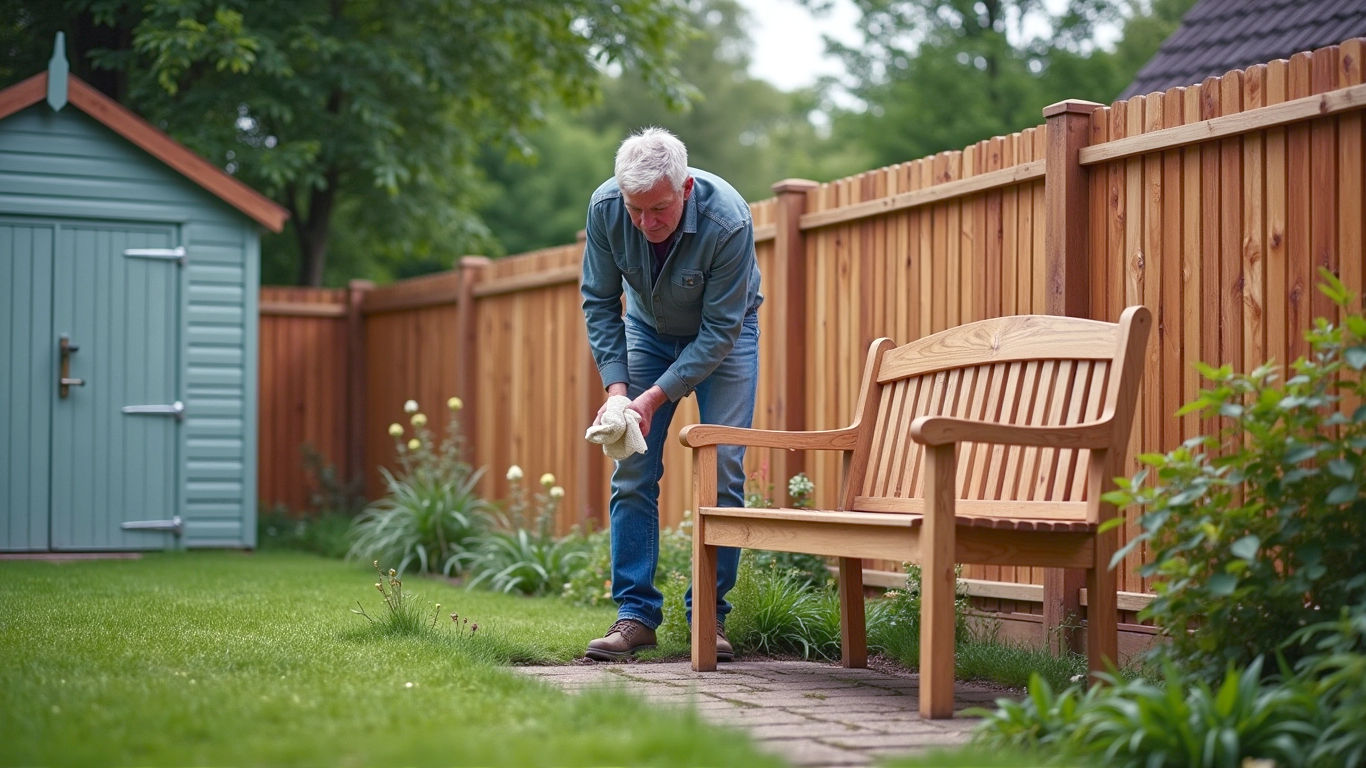
This post may contain affiliate links. If you make a purchase through these links, we may earn a commission at no additional cost to you.
Let’s be honest, we’ve all been there. You look out at the garden you’ve spent ages perfecting, and your eyes land on it: the shed is looking a bit sorry for itself, the fence has a distinct green tinge that isn’t moss, and the decking has seen better days. Wood is a beautiful, natural material, but in our damp British climate, it’s in a constant battle against the elements.
Without a bit of help, that sturdy fence or handsome garden bench can quickly fall victim to rot, insects, and decay. But protecting it feels like a minefield of confusing terms. What on earth is ‘tanalised’ timber? Is ‘dip treated’ just a fancy way of saying it’s had a quick bath? And should you use an oil, a stain, or a lick of paint?
Fear not. This is your ultimate, no-nonsense guide to choosing the right wood preservative. We’ll break down exactly what each treatment does, where it works best, and how you can make the right choice for your fence, shed, decking, or garden furniture. By the end, you’ll be able to walk into a timber yard or DIY shop with complete confidence, ready to give your garden wood the long, happy life it deserves.
First Things First: Why Does Wood Go Bad?
Before we dive into the solutions, let’s quickly understand the enemy. When we talk about wood ‘going bad’, we’re usually talking about three main culprits, all of which thrive in the damp conditions our British weather so generously provides.
- Fungal Decay (Rot): This is the big one. Microscopic fungi spores are everywhere in the air. When they land on damp wood, they spring to life, feeding on the wood itself and causing it to break down. This is what we call rot. There are different types, like wet rot (which makes wood feel spongy and look dark) and dry rot (which is more serious and can spread through buildings), but in the garden, it’s all bad news.
- Insect Attack: Wood can also be a tasty meal for certain insects. Wood-boring beetles, often collectively known as ‘woodworm’, lay their eggs in timber. The larvae then tunnel through the wood for years, weakening it from the inside out before emerging as adult beetles, leaving tell-tale little holes behind.
- The Weather: Rain, sun, and frost all play their part. Water soaks into the wood, causing it to swell. The sun’s UV rays then dry it out and bleach its colour, making it shrink. This constant cycle of swelling and shrinking causes wood to split, crack, and warp, creating more little gaps for water and fungal spores to get in.
A good wood preservative has to fight on all three fronts: it needs to be a fungicide (to kill fungus), an insecticide (to kill insects), and a water repellent (to protect against the weather). Now, let’s look at how our main contenders achieve this.
The Heavyweight Champion: Pressure Treatment
If you’ve ever bought fence posts or decking boards that have a greenish or light brown tint and feel slightly damp, you’ve encountered pressure-treated wood. This is the gold standard for protecting timber that will face the harshest conditions, especially wood that will be in direct contact with the ground.
It’s often called ‘tanalised’ timber, which is actually a brand name (like Hoover for vacuum cleaners) for a specific type of pressure treatment, but the term has stuck.
How Does Pressure Treatment Work?
This isn’t a quick job; it’s a highly effective industrial process. Think of it like giving the wood a vaccine, right down to its core.
- Loading: Regular kiln-dried timber (often pine or spruce) is loaded into a huge, sealed cylinder called an autoclave.
- Vacuum: All the air is sucked out of the cylinder. This creates a vacuum, which also pulls the air out of all the tiny cells within the wood.
- Flooding: The cylinder is then flooded with a liquid preservative solution, a carefully balanced cocktail of fungicides and insecticides.
- Pressure: The cylinder is pressurised, which forces the preservative deep into the timber, penetrating right to the centre of the wood. It’s this step that gives it the name pressure treatment.
- Final Vacuum: The excess preservative is drained, and a final vacuum sucks out any surplus, leaving the chemicals locked deep inside the wood’s structure.
The result is timber that is protected from the inside out. The preservative isn’t just a coating; it’s become part of the wood itself.
The Chemicals: From CCA to Modern Solutions
For decades, the preservative used was called Chromated Copper Arsenate (CCA). It was incredibly effective, but concerns over the arsenic and chromium led to its use being restricted across the UK and Europe in 2004. You can no longer buy CCA-treated timber for residential use.
Today, the preservatives are much safer for people and the environment. They are typically copper-based (which is what gives the wood its initial green tint), mixed with modern, biodegradable organic compounds. The most common type you’ll see in the UK is often called ‘Tanalith E’ or ‘ACQ’ (Alkaline Copper Quaternary). This modern treatment is perfectly safe for use in gardens, around children, and for pets once dry.
Understanding Use Classes (UC)
Not all pressure-treated wood is the same. It’s treated to different levels depending on how it will be used. This is known as its Use Class. It’s crucial to get this right.
- UC1 & UC2 (Indoors): For internal timber that won’t get wet, like roof trusses or floor joists. You won’t find this in a garden centre.
- UC3 (Outdoors, Above Ground): This is for timber that will be outside and exposed to the weather, but not touching the ground. Think fence panels, shed walls, and decking boards.
- UC4 (Outdoors, In Ground Contact): This is a higher level of treatment for timber that will be in permanent contact with the ground or fresh water. It’s essential for fence posts, gravel boards, and decking support joists. Using UC3 timber for these jobs is a false economy; it will rot at ground level within a few years.
- UC5 (Marine Use): A specialist class for timber used in saltwater, like jetties and docks.
Always check the Use Class when buying timber. Any good supplier will have it clearly marked. If you’re putting a post in the ground, it must be UC4.
Pros and Cons of Pressure-Treated Wood
Pros:
Cons:
The Budget-Friendly Option: Dip Treatment
Dip treatment is a much quicker and cheaper method of preserving wood. It’s very common for the budget-friendly fence panels and sheds you’ll find in DIY superstores.
How Does Dip Treatment Work?
The name gives it away. Instead of the high-tech pressure-and-vacuum process, dip treatment is exactly what it sounds like.
- The timber panels or components are fully submerged in a large, open tank filled with a preservative solution.
- They are left to soak for a short period.
- They are then lifted out and left to dry.
The preservative soaks into the surface layers of the wood, but it doesn’t penetrate nearly as deeply as it does with pressure treatment. Think of it more like a protective jacket than a vaccine. It offers a good initial defence, but it’s a defence that needs regular top-ups.
The colour is often a darker, golden-brown or orangey shade, which comes from a dye added to the treatment so you can see it’s been applied.
Pros and Cons of Dip-Treated Wood
Pros:
Cons:
The Finishing Touch: Paints, Stains, Oils, and Varnishes
The final category covers all the tins of colourful stuff you can buy to brush onto your wood. Unlike pressure or dip treatments, which are done before you buy the timber, these are surface coatings that you apply yourself.
These coatings work in a different way. Their primary job is to create a physical barrier on the surface of the wood, shielding it from water and UV rays. Many also contain fungicides and biocides to stop rot and mould from taking hold on the surface.
You can apply these to untreated wood, but they are also brilliant for adding extra protection and a splash of colour to both dip-treated and pressure-treated timber.
Let’s break down the main types.
Wood Paints
Garden wood paints create a solid, opaque film that sits on top of the wood. They completely cover the grain and offer a huge range of colours, from classic sage green and slate grey to vibrant blues and pinks.
- How they work: By forming a thick, flexible, and often microporous (breathable) layer, they provide an excellent barrier against rain and sun. The pigment in the paint is what blocks the damaging UV rays.
- Best for: Sheds, summerhouses, fences, and garden furniture where you want a block of colour and maximum weather protection.
Pros:
Cons:
Top Rated UK Wood Paints To Consider
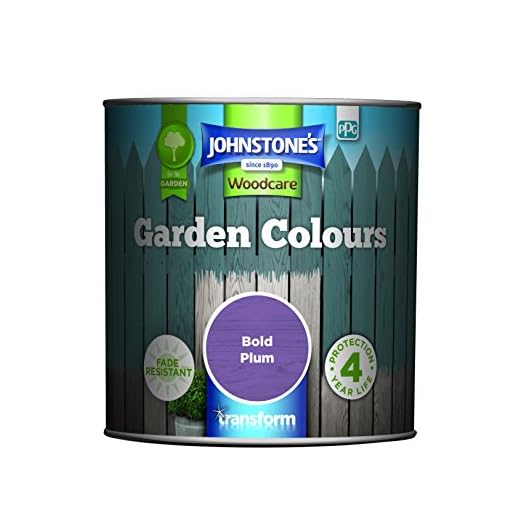
Johnstone’s – Garden Colours – Bold Plum – Exterior Wood Paint – Fade Resistant – Suitable for Garden Furniture Outdoors – Fence Paint – Dry in 2 hours -…
![RONSEAL GARDEN PAINT SAGE 750ML [37395]](https://m.media-amazon.com/images/I/41bdDm-uTOL._SS520_.jpg)
RONSEAL GARDEN PAINT SAGE 750ML [37395]
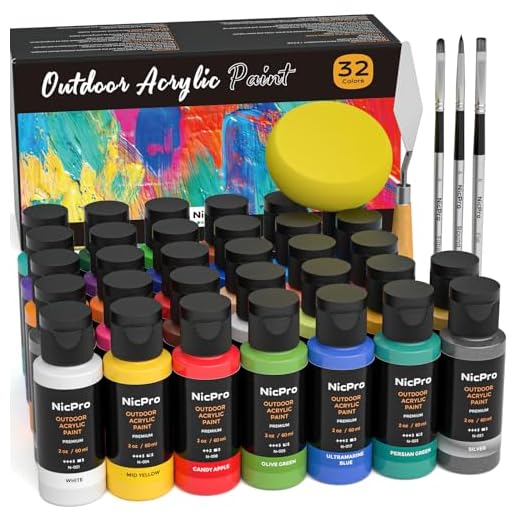
Nicpro 32 Colors Outdoor Acrylic Paint Bulk with Brush and Sponge, Knife, Non-Toxic Paint for Multi-surface Rock, Wood, Fabric, Leather, Crafts, Canvas,…

Ronseal 10 Year Weatherproof 2-in-1 Wood Paint Dark Oak Gloss 750ml

Cuprinol Garden Shades Wood Paint – Cornflower – 1L

Ronseal 10 Year Weatherproof 2 in 1 Wood Paint Black Satin 750ml

Ronseal 10 Year Weatherproof 2-in-1 Wood Paint Spring Green Satin 750ml
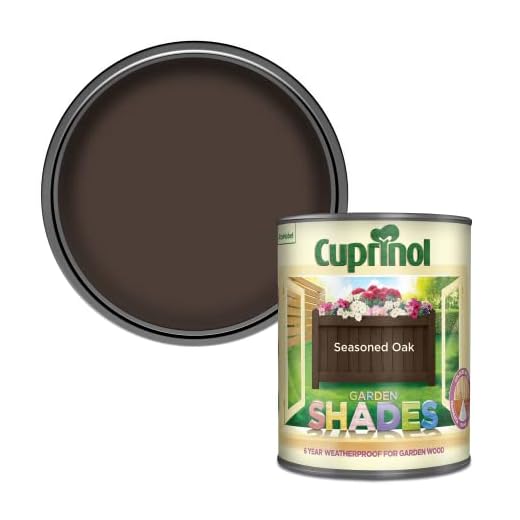
Cuprinol GSSO1L Garden Shades Seasoned Oak 1 Litre

RONSEAL 10 Year Weatherproof 2-in-1 Wood Paint Grey Satin 750ml
Wood Stains
Wood stains are semi-transparent. They contain pigment to add colour, but not enough to hide the wood grain completely. They are designed to penetrate into the surface of the wood, rather than just forming a film on top.
- How they work: Stains soak into the wood fibres, colouring them and providing a water-repellent finish. They also contain UV blockers and fungicides.
- Best for: Fences, sheds, and decking where you want to add colour while still seeing the natural texture of the wood.
Pros:
Cons:
Top Rated Wood Stains Worth A Look

Roxil Wood Waterproofing Liquid (5L Clear) Preserver Outdoor, Sealer for decking, Fence, Sheds and Furniture
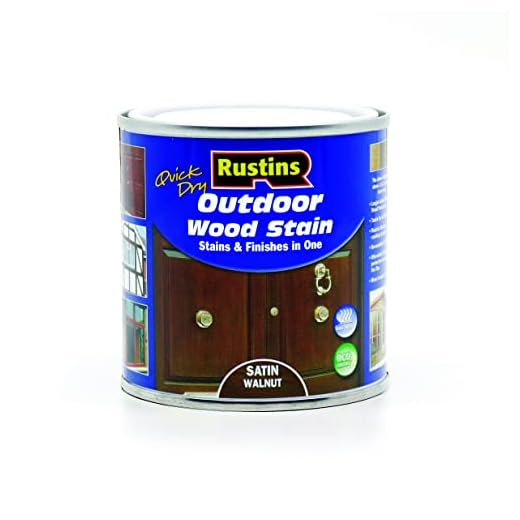
Rustins Quick Dry Outdoor Wood Stain Satin Walnut 250ml- Durable and Weather-Resistant Finish, Fast Drying, Vibrant Color for Decks, Fences, & Furniture,...

Rustins TLLO1000 1L Timberlife Oak - Light, Brown

RONSEAL 10 Year Woodstain Natural Oak 750ml

Johnstone's Woodcare Indoor and Outdoor Woodstain - Natural Oak 250ml
Wood Oils & Waxes
Wood oils, like decking oil or furniture oil, are designed to nourish the wood and enhance its natural colour and grain. They are most popular for hardwood decking and garden furniture.
- How they work: They soak deep into the wood, replacing the natural oils that are washed out by sun and rain. This keeps the wood supple and stops it from drying out, splitting, and warping. They provide a water-resistant finish but offer less protection than paints or stains.
- Best for: Hardwood furniture (like teak, oak, or acacia) and decking. They give a beautiful, rich, natural-looking finish.
Pros:
Cons:
Top Rated Wood Oils and Waxes To Try

Nordicare Sealing Wood Oil for Outdoor Garden Furniture - Teak Oil for Garden Furniture - Suitable for All Outdoor Types of Wood, for Wood Exterior...

GRAIN GUARD Hard Wax Oil for Wood | 500ml | Water & Stain Resistant Protection | Interior Wood Flooring & Surfaces | Long Lasting Wood Protection | for All...

GRAIN GUARD Sealing Oil for Wood | 500ml | Protects Against Weather & UV | For Garden Furniture & Decking | Teak & Danish Oil Blend
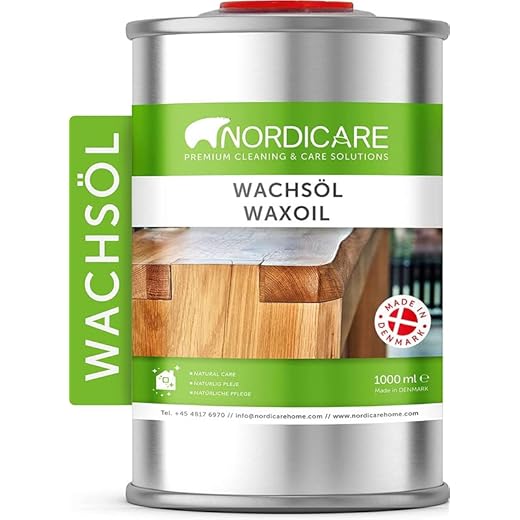
Nordicare Hard Wax Oil - Colourless Wood Finish - Wax Oil for Various Woods (Walnut, Oak, Mahogany, Dark Teak, Cherry) - Made in Denmark (1 L)

Ronseal UHWGFOO1L 1 Litre Ultimate Protection Hardwood Garden Furniture Oil - Oak

PIPIHUA Beeswax Polish for Wood & Furniture - Natural Wood Wax for All Types, Furniture Polish to Enhance & Protect Any Wooden Surface, 480ml

Osmo UV Protection Oil Extra for Exterior Wood, Clear Matt 1420 for Vertical Structures (Clear Matt, 0.75L)

Furniture Clinic Wood Stain (Natural Oak) – Fast Drying, Highly Concentrated, and Easy-to-Apply Light Oak Wood Stain for All Indoor & Outdoor Wood – Water...

Osmo UV-Protection Oil Extra - Wood Preserver Outdoor 420, Clear Satin, 2.5L - Durable Oil for Wooden Outdoor Surfaces, Water & Dirt Resistant, Wood...

Bartoline Teak Oil 500 ml – Deep Penetrating Wood Oil for Outdoor & Indoor Furniture | Garden Furniture, Hardwood Protection & Teak Care
Varnishes & Lacquers
Varnishes create a hard, transparent, and durable film on the surface of the wood. They are less common for general garden use in the UK.
- How they work: They form a tough, plastic-like coating that is highly resistant to water, scratches, and knocks.
- Best for: Specific applications like wooden front doors or window frames where a hard-wearing, glossy finish is needed.
Pros:
Cons:
Top Varnishes and Lacquers To Consider

Rustins Quick Dry Outdoor Clear Varnish 500ml Matt

Rustins Quick Dry Varnish Clear Gloss 250ml
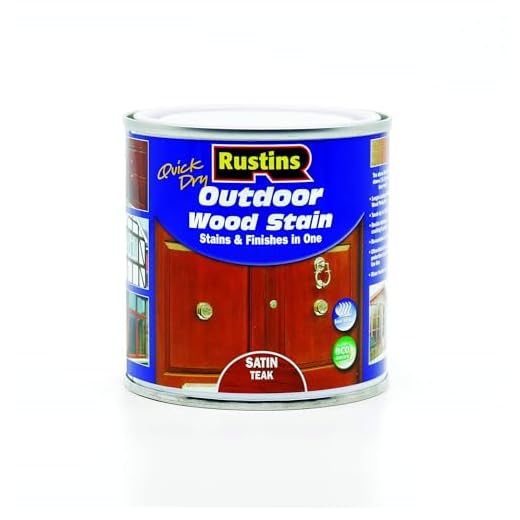
Rustins Quick Dry Outdoor Wood Satin Teak 250ml- Durable and Weather-Resistant Finish, Fast Drying, Vibrant Color for Decks, Fences, & Furniture, Available...

Extra Tough Wood Varnish - 250ml - Fast Drying, Clear Varnish - Low Odour, Water-Based - Protects Interior Wood from Scratches and Stains - Gloss

RUSTINS Quick Drying Poly Varnish Satin Clear 250ml

RUSTINS QD Poly Varnish Satin Clear 500ml

QD Poly Varnish Gloss Clear 1ltr

Rustins Quick Dry Varnish Clear Satin 500ml
The Big Question: Which Treatment Should You Choose?
Okay, we’ve covered the science. Now for the practical bit. The best choice depends entirely on your project, your budget, and how much maintenance you’re willing to do.
Let’s run through some common garden projects.
For Fences
- Fence Posts: Non-negotiable. Must be UC4 pressure treated. Any post you put in the ground has to be able to withstand constant moisture. Anything less is a waste of time and money.
- Gravel Boards: The board that runs along the bottom of the fence. Same rule applies: Must be UC4 pressure treated as it’s in contact with the ground.
- Fence Panels:
- Best Option (Longevity): Pressure-treated panels (UC3). They cost more, but will last 15+ years with minimal fuss.
- Best Option (Budget): Dip-treated panels. They are cheap to buy, but you must commit to re-treating them with a brush-on preservative, stain, or paint every couple of years. If you don’t, they will fail much sooner.
Can you paint treated fence panels? Absolutely! Painting or staining pressure-treated or dip-treated panels adds an extra layer of water-repellency and UV protection, prolonging their life and making them look great. Just remember to let new pressure-treated wood dry out for a few months first.
For Sheds & Summerhouses
- Best Option (Longevity): A pressure-treated shed. It’s protected right through the core of its timbers and is far more resistant to rot, especially at the base where it’s closest to the damp ground.
- Best Option (Budget): A dip-treated shed. Again, it’s a perfectly good option as long as you are diligent with maintenance. You’ll need to apply a good quality shed paint or stain within the first year and repeat every few years.
Top Tip for Sheds: Whatever type of shed you buy, make sure it’s sitting on a solid, level base that keeps the timber off the damp ground. Pressure-treated floor bearers are a massive advantage here.
For Decking
- Decking Joists (the support frame): Just like fence posts, these are structural and often in damp, dark places. They must be UC4 pressure treated.
- Decking Boards: These should be UC3 pressure treated as a minimum. But the story doesn’t end there. The top surface is battered by rain and sun, and people walk all over it. The pressure treatment will stop it from rotting, but it won’t stop it from splitting, warping, and turning a washed-out silvery-grey.
- Essential Maintenance: To keep your deck looking good and feeling safe underfoot, you must apply a decking oil or stain every year. This will replenish its water-repellency and protect it from the sun, keeping the colour rich and preventing cracks.
For Garden Furniture
- Hardwood Furniture (e.g., Teak, Oak): This furniture is naturally durable and oily. Don’t paint or varnish it. The best approach is to clean it and apply a good quality furniture oil once or twice a year to keep it nourished and looking its best.
- Softwood Furniture (e.g., Pine): This is much less durable and needs more help. If it’s pressure-treated, it’s protected from rot, but will still benefit from a coating. Your best bet is either a wood stain to add colour while keeping the woody look, or a good garden furniture paint for a complete colour transformation and excellent weather protection.
For Raised Beds & Kids’ Play Equipment
Safety is the number one priority here. You need something that is protected from rot but is also non-toxic.
- Best Option: Use timber treated with modern ACQ/Tanalith E preservatives (the non-arsenic kind). This is safe for this type of use. To be extra safe, you can line the inside of a raised bed with a plastic membrane to separate the soil from the timber.
- Finishes: If you want to add colour, look for paints and stains that are certified as ‘child safe’ or ‘toy safe’ (look for EN 71 certification). These products don’t contain any harmful heavy metals.
Final Practical Tips From The Shed
- Always Treat Cut Ends: I’m saying it again because it’s so important. When you cut treated wood, you expose the unprotected core. Buy a tin of end-grain preserver and liberally coat any sawn ends before you assemble your project.
- Let New Treated Wood Dry: Don’t be tempted to paint that brand new pressure-treated fence straight away. The preservative leaves the wood wet, and the paint won’t stick properly. Let it weather for at least a few months until it feels completely dry and looks a lighter colour.
- Preparation is Everything: When re-treating any wood, 90% of the job is preparation. Use a stiff brush and a wood cleaner to scrub off all dirt, mould, and loose material first. If you paint over dirt, the paint is sticking to the dirt, not the wood, and it will fail quickly.
- Don’t Burn It: Never, ever burn offcuts of pressure-treated or dip-treated wood in your home fire or garden bonfire. The preservative chemicals can release toxic fumes. Your local council recycling centre will have a specific skip for treated timber.
- Read the Tin: Different products have different rules. Always read the instructions on the tin of paint, stain, or oil you are using. It will tell you the best way to apply it and how often it needs re-doing.
Choosing the right wood preservative isn’t about finding a single ‘best’ product, but about understanding the trade-offs between cost, longevity, appearance, and maintenance. By matching the treatment to the job, you can ensure your garden timber looks fantastic and stands up to the British weather for many years to come.
Further Reading & Resources
For those wishing to delve even deeper, these resources provide professional-grade information and standards for wood treatment in the UK.
- Wood Protection Association (WPA): The UK’s leading authority on wood preservation. A fantastic resource for technical details. https://www.thewpa.org.uk/
- Timber Decking and Cladding Association (TDCA): Offers best-practice guides and technical advice specifically for decking and cladding projects. https://www.tdca.org.uk/
- GOV.UK Guidance on Waste Wood: The official information on how to correctly identify and dispose of treated wood. https://www.gov.uk/government/collections/waste-wood






